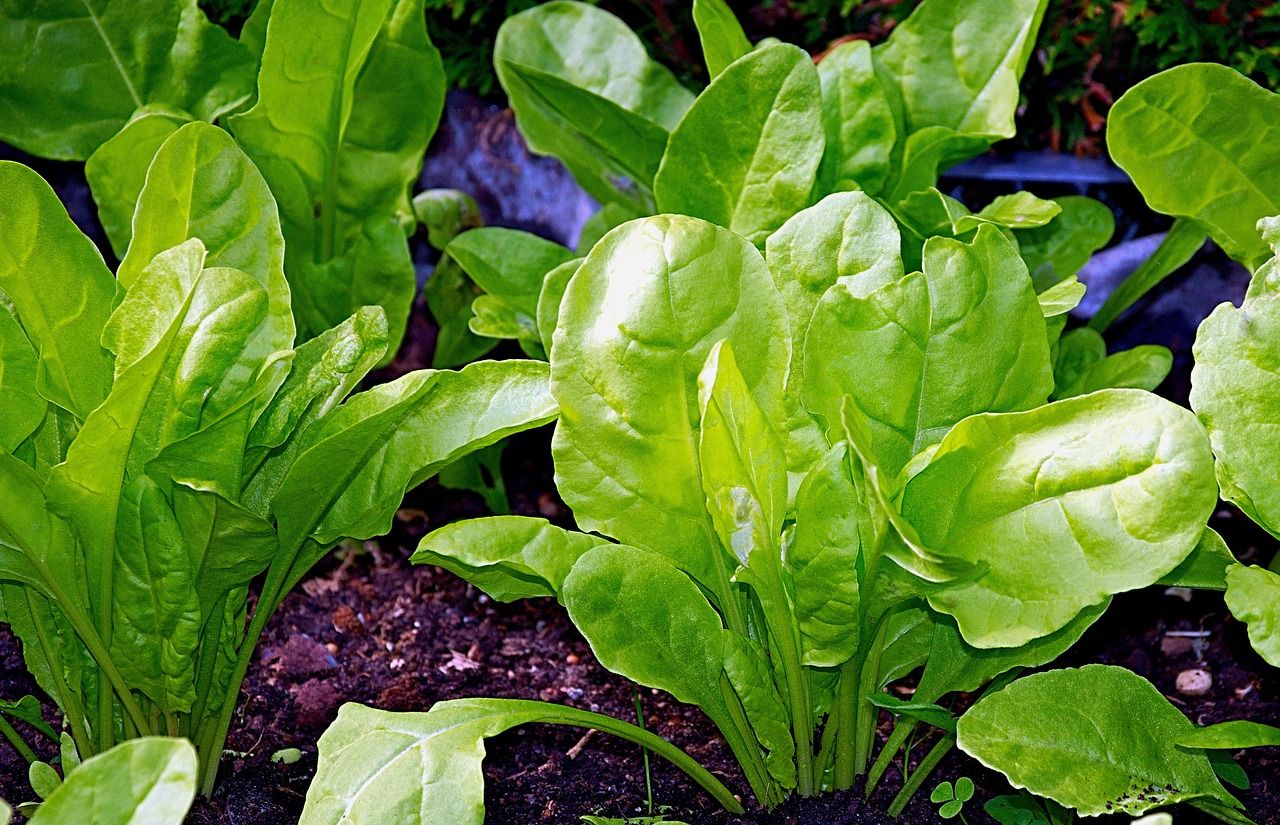Perpetual spinach chard is a rare leafy vegetable that thrives in subtropical climates. With its rich heritage and impressive adaptability, this hardy plant is a must-have for gardeners residing in warmer zones 9 through 11.
Perpetual spinach chard, scientifically known as Beta vulgaris subsp. cicla var. cicla ‘Perpetual Spinach’, belongs to the beet family. It is believed to have originated in the Mediterranean region, where it was cultivated for centuries. This versatile vegetable has a long history of culinary use, with its origins dating back to ancient Greek and Roman times.
Perpetual Spinach Chard Plant Details
Perpetual spinach chard features large, tender leaves that are glossy and dark green, similar to true spinach but with a slightly thicker texture. The leaves grow on sturdy, succulent stalks.
The plant has a biennial growth habit, although it is often cultivated as an annual in cooler climates. It typically reaches maturity within 55 to 60 days from sowing. When fully grown, this leafy vegetable forms a compact rosette of lush foliage, reaching a height of about 12 to 18 inches and spreading approximately 12 inches in width. Its compact size makes it an excellent choice for container gardening as well.
Where and When to Grow Perpetual Spinach
For gardeners residing in the U.S. perpetual spinach chard thrives in subtropical regions with warmer climates. Specifically, it performs exceptionally well in USDA Hardiness Zones 9 through 11. The milder winters and longer growing seasons found in these areas create the perfect conditions for this robust leafy green.
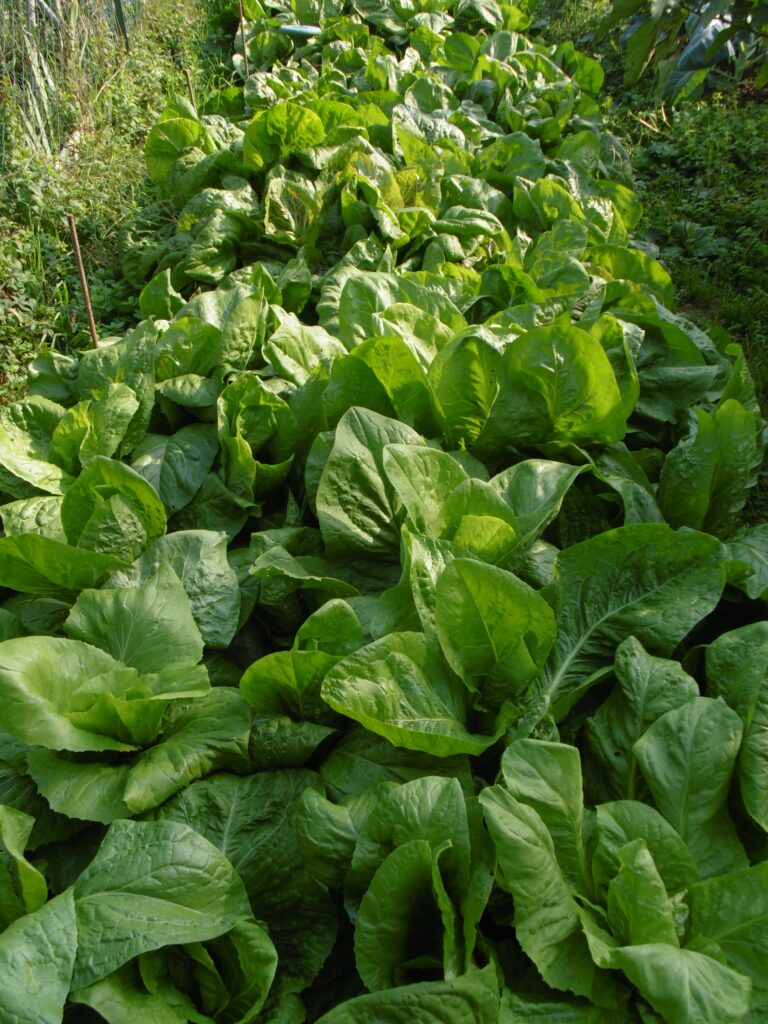
Optimal Growing Conditions for Perpetual Spinach Chard
For the best results and the most abundant harvest, keep the following factors in mind.
Temperature
Perpetual spinach chard thrives in moderate temperatures, preferring a range between 60°F and 80°F. However, it is very heat tolerant and will tolerate cold snaps down to 32°F. Growth will slow during extreme heat and cold.
Humidity
The plant prefers moderate humidity levels. While it can tolerate higher humidity, it is important to provide good air circulation to prevent fungal diseases.
Sunlight
Perpetual spinach chard requires full sun to partial shade, with a minimum of 4 to 6 hours of direct sunlight each day. In hotter regions, providing some afternoon shade can help prevent wilting or scorching of the leaves. It’s suitable for shady patches of the garden in subtropical zones.
Soil Type
It thrives in well-drained, fertile soil rich in organic matter. It prefers a slightly acidic to neutral pH level between 6.0 and 7.0. Amending the soil with compost or well-rotted manure before planting will help provide the necessary nutrients and improve soil structure.
Planting Times
Since perpetual chard acts as a perennial edible plant in subtropical zones, you can plant it nearly any time of year. However, avoid planting out during the hottest or coldest times.
For spring planting, start indoors up to 8 weeks before the last frost date and plant out once that date has passed.
In the summer or fall, start seeds indoors, and plant out once the plant has fully developed (about 8 weeks). For best cold resilience, sow and establish at least one month before the first frost date.
Starting Perpetual Spinach Chard Seeds
We recommend starting perpetual chard seeds in cell trays or soil blocks. This allows you to plant out a healthy, well-developed young plant that is more resistant to pests and disease.
- Fill cell trays or soil blocks with a high-quality seed-starting mix, moistening it slightly before planting.
- Sow the seeds about ¼ to ½ inch deep.
- Place the trays or blocks in a warm location with temperatures around 70°F to 75°F.
- Maintain consistent moisture by misting the soil surface or using a bottom-watering technique.
- Germination typically occurs within 7 to 14 days.
Once the seedlings have developed their second set of true leaves, you can transplant them into the garden. However, we recommend planting out once the plant is 6” and has developed several sets of true leaves. This ensures it will better survive transplant shock or environmental pressures.
Transplanting Perpetual Spinach Chard
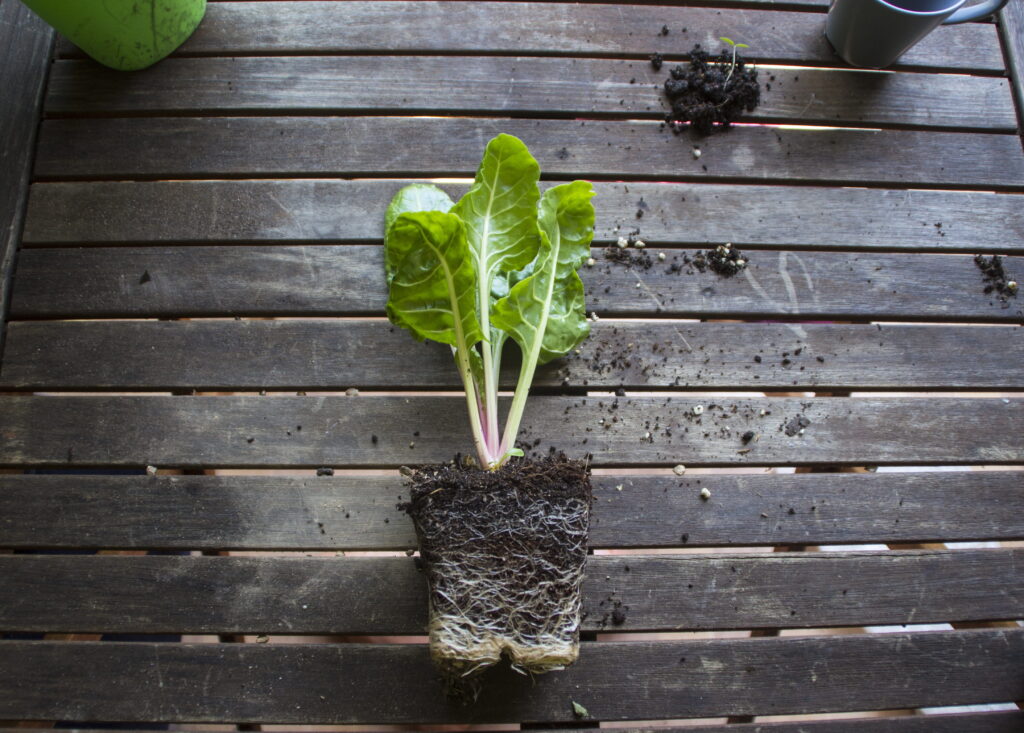
Once you have healthy young seedlings, you’ll want to transplant them into your garden or into a larger container.
Into Garden Beds:
- Choose a well-prepared garden bed with loose, amended soil.
- Dig holes that are slightly larger than the root ball of the seedling.
- Gently remove the seedlings from the module cell or soil block tray, taking care not to damage the roots.
- Place the seedlings into the holes and backfill with soil, firming it gently around the base of the plants.
- Space the plants 8 to 12 inches (20 to 30 cm) apart to allow sufficient room for growth.
- Water the newly transplanted seedlings thoroughly to help them establish.
Into Containers:
Select containers that are at least 6 to 8 inches deep to accommodate the root system.
- Fill the containers with a well-draining potting mix, leaving about an inch of space below the rim.
- Gently remove the seedlings from the cell trays or soil block trays, being careful not to disturb the roots.
- Place the seedlings in the center of each container and fill in the remaining space with potting mix.
- Water the containers thoroughly until excess water drains from the bottom.
Temp Tolerance for Perpetual Spinach
Perpetual chard may require some extra care when the weather is extreme.
Protect from Excessive Heat
High temperatures above 95°F can cause the leaves to wilt, scorch, and lose flavor. Providing shade or mulching can help protect the plants during extreme heat.
Protection from Cold
To protect perpetual chard from a deep cold snap, apply a layer of mulch around the base of the plants to insulate the roots and conserve moisture. Cover the plants with row covers or frost blankets during freezing temperatures.
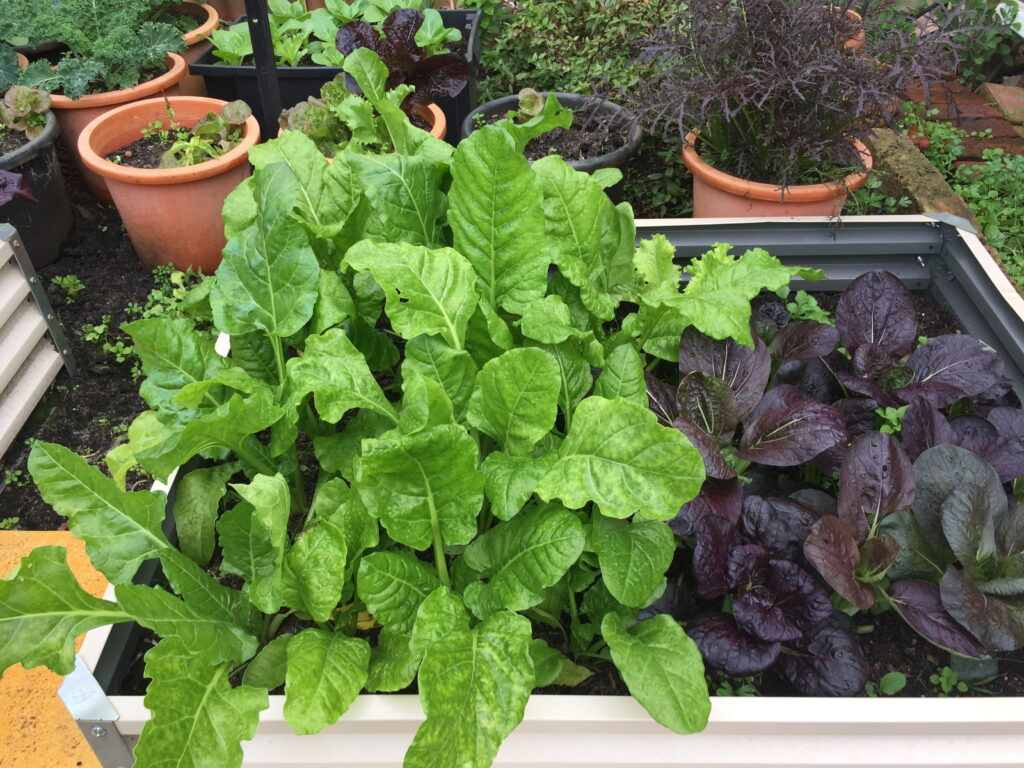
Watering Schedule
During the winter and spring, water the plants deeply once or twice a week, ensuring the soil remains consistently moist but not waterlogged.
During the summer and fall, water as needed to provide moisture if it doesn’t rain adequately.
Fertilizer Composition and Schedule
Prior to planting, incorporate compost or well-rotted manure into the soil for nutrient enrichment.
During the growing season, apply a balanced organic fertilizer or a slow-release granular fertilizer according to the package instructions every 4 to 6 weeks.
Avoid excessive nitrogen fertilization, as it can promote leafy growth at the expense of root development. Opt for a balanced fertilizer instead.
Common Pests
Perpetual spinach chard may be subject to a few pests.
Aphids: Use a strong blast of water or insecticidal soap to control aphid infestations.
Slugs and Snails: We recommend Sluggo baits, which are very effective, very affordable, and certified OMRI for organic use.
Leaf Miners: Remove infested leaves and destroy them to reduce leaf miner populations.
Caterpillars: Handpick caterpillars or use organic insecticides labeled for vegetable use. We recommend products containing a naturally occurring bacteria called Bacillus thuringiensis (or bt for short), such as Thuricide.
Similar products that contain Spinosad are also organic and are affective against a wider range of pest insects, including aphids. Monterey’s Spinosad is an excellent choice.
Common Diseases
Downy Mildew: Ensure good air circulation, avoid overhead watering, and apply appropriate fungicides if necessary.
Leaf Spot: Remove affected leaves and practice good sanitation to prevent the spread of the disease.
For significant infections, we recommend applying an organic copper spray after removing the affected foliage.
Powdery Mildew: Improve air circulation, avoid overhead watering, and apply fungicides labeled for powdery mildew control. Apply a mixture of 8 Tbs of household hydrogen peroxide (3%) mixed with one gallon of water with a sprayer every three days for a week or two for an inexpensive organic fungicide against powdery mildew.
Regularly monitor your plants for any signs of pests or diseases and take prompt action to prevent damage or spread.
Special Needs and Care for Perpetual Spinach Chard
Thinning: When sowing directly, think seedlings when they reach a height of about 2 to 3 inches to ensure proper spacing between plants. Remove the weaker seedlings, leaving the healthiest and strongest ones to grow. These plants grow best when spaced at around 12”.
Mulching: Apply a layer of organic mulch around the base of the plants to help conserve moisture, suppress weed growth, and regulate soil temperature.
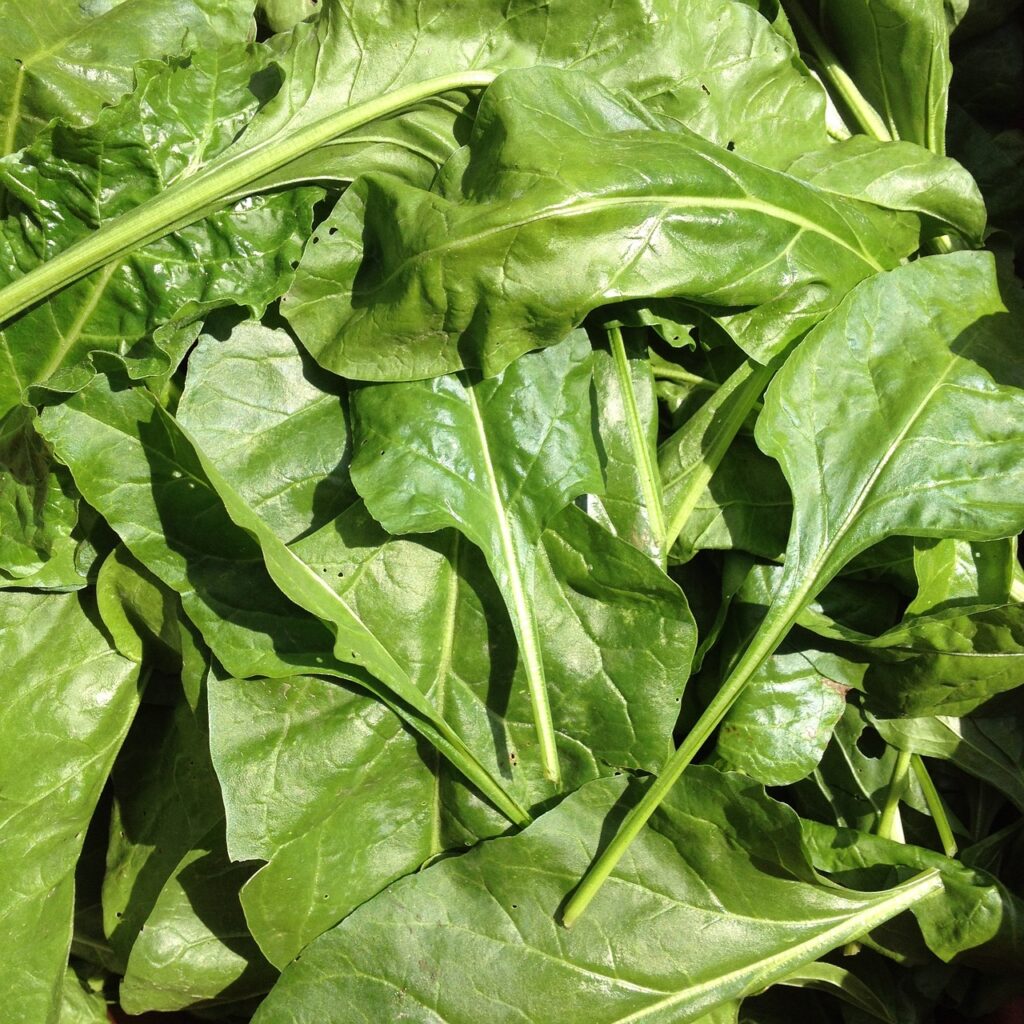
Companion Plants for Perpetual Spinach
Perpetual spinach chard can benefit from companion planting, which involves growing compatible plants in close proximity to enhance growth, deter pests, and promote overall garden health. Here are some suitable companion plants for perpetual chard:
Herbs
Plant aromatic herbs like basil, dill, parsley, and cilantro near perpetual spinach chard to repel pests and attract beneficial insects.
Nasturtiums
Nasturtiums serve as sacrificial plants, attracting pests like aphids away from perpetual chard.
Harvesting Perpetual Spinach
Regularly harvest outer leaves when they reach a size of about 6 to 8 inches long. This will encourage continuous growth and prevent the plants from bolting.
If the plants start to bolt (produce flower stalks), it is best to remove them to maintain quality. Alternatively, you can allow them to flower for your bee population and to collect seeds once matured.
Perpetual chard can be harvested as soon as the outer leaves reach a desirable size. Here’s how to harvest:
- Select the outer leaves, starting with the largest ones, leaving the smaller inner leaves to continue growing.
- Use a sharp knife or scissors to cut the leaves off at the base, or you can gently twist and pull them from the stem.
- Harvest regularly to encourage new leaf growth and a continuous harvest throughout the growing season.
Cooking with Perpetual Spinach

Perpetual spinach chard is a versatile leafy green that can be enjoyed in various culinary creations. Here are some cooking and meal ideas:
Fresh Salads
Use young and tender leaves as a nutritious base for salads. Mix with other greens, add your favorite toppings, and dress with a light vinaigrette.
Sautéed or Stir-Fried
Heat olive oil or butter in a pan, add chopped leaves, and sauté with garlic, onions, or other vegetables for a flavorful side dish. Stir-frying with soy sauce and sesame oil also creates a delicious Asian-inspired dish.
Quiches and Frittatas
Add cooked and chopped leaves to quiches, frittatas, or egg muffins for a nutrient-packed and flavorful meal.
Soups and Stews
Incorporate into soups, stews, or hearty winter dishes for added nutrition and a vibrant green color.
Wraps and Sandwiches
Use large perpetual spinach chard leaves as a substitute for tortillas or bread in wraps and sandwiches for a healthy and low-carb option.
Experiment with different recipes and cooking techniques to make the most of the versatile chard in your culinary endeavors. Enjoy the fresh and vibrant flavors it brings to your meals!
Your Subtropical Garden Needs Perpetual Spinach Chard
Perpetual chard is a versatile and visually appealing addition to subtropical gardens in the United States. Its origins in the Mediterranean region and its ability to flourish in warmer climates make it an ideal choice for gardeners in USDA Hardiness Zones 9 through 11.
Whether used as an ornamental plant or harvested as a nutritious leafy green, perpetual spinach chard offers gardeners a delightful and productive gardening experience.
You can purchase seeds for perpetual spinach chard from our website.
FAQ – Frequently Asked Questions About Growing and Using Perpetual Spinach
Why is it called perpetual spinach?
Perpetual spinach got its name because it produces a continuous harvest of spinach-like leaves throughout the growing season.
What are some perpetual spinach chard benefits?
Perpetual chard is packed with vitamins, minerals, and antioxidants, supports immune health, promotes digestion, and provides essential nutrients.
What is the difference between spinach and perpetual spinach?
It has thicker leaves and sturdier stalks compared to true spinach. It is much more heat tolerant and tends to have a longer growing season.
Does perpetual spinach taste like spinach?
Yes, it has a mild, slightly sweet taste similar to true spinach but with a heartier texture.
Can you eat perpetual spinach stalks?
Yes, the succulent stalks are edible and can be enjoyed in various culinary preparations.
Is perpetual spinach the same as chard?
Yes, perpetual spinach is a type of chard, specifically a variety that resembles and tastes like true spinach.
What is another name for perpetual spinach?
Another name for perpetual spinach is “leaf beet.”
What grows well with perpetual spinach?
It grows well with herbs like basil and dill, brassicas like broccoli, and beans.
How do you cook perpetual spinach?
You can cook it by sautéing, stir-frying, adding to soups or stews, or using it raw in salads and wraps.
How long will perpetual spinach last?
With regular harvesting and proper care, you’ll get a continuous harvest for several months. In subtropical regions with mild winters, it will easily last for a year or more.
What is perpetual spinach good for?
It’s good for adding nutrition to meals, supporting overall health, and providing a versatile leafy green option in climates that are too hot to grow traditional salad greens.
How do you maintain perpetual spinach?
Maintain the plant by ensuring consistent moisture, proper spacing, regular harvesting, and protecting from extreme temperatures.
Where do you cut perpetual spinach?
When harvesting, cut the outer leaves close to the base of the plant, leaving the inner leaves to continue growing.
What does perpetual spinach taste like?
It has a mild, slightly sweet taste with a hint of nuttiness.
Is perpetual spinach the same as New Zealand spinach?
No, perpetual spinach and New Zealand spinach are different plants, although they are both leafy greens commonly used as spinach alternatives.
